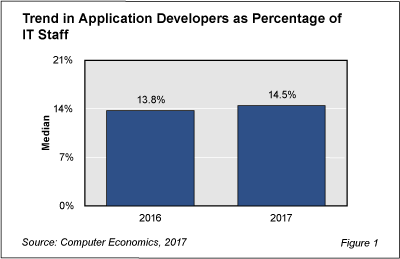Despite the growing use of commercial software, application developers continue to make up a larger percentage of the typical IT staff.
There are several trends working to increase the demand for this critical IT skill set. First, the footprint of business applications is becoming wider. Organizations are automating ever more business processes, connecting with customers and suppliers, and analyzing increasing volumes of business data. Mobile devices add another dimension and an increased set of requirements. All of these drive the need for new business systems and application developers.
At the same time, the trend toward commercial software and SaaS applications does not mean the death of application developers. Application developers are still needed to tailor, configure, and build extensions. At the same time, platform-as-a-service allows developers to rapidly build extensions to SaaS applications and even entirely new systems. Although the improved customizability of SaaS, as well as the increased use of cloud services, might one day reduce the overall demand for application developers, it appears that organizations today are using the productivity gains as an opportunity to give their application developers more work.
As shown in Figure 1 from the full report, Application Developer Staffing Ratios, over the past two years (before 2016, we did not divide application maintenance and application developer staff into two separate job positions) there is a small but noticeable increase in the application developer staffing level. Application developer personnel rose from a median 13.8% of the IT staff in 2016 to 14.5% in 2017, based on our annual survey of more than 200 IT organizations.

With the changing environment, the need for application developers is in flux, and given the shortage and high cost of well-trained application developers, IT organizations can benefit from periodic assessment of their application development staffing levels.
“Given the cost of application developer talent, it is important to keep track of trends in staffing in this area,” said David Wagner, vice president research at Computer Economics, an IT research firm based in Irvine, Calif. “If an IT department can find a way to use fewer developers to meet the needs of the business, it is something to consider.”
We use the term “application developer” to denote application programmers, systems analysts, software engineers, solutions architects, and other personnel who engage in the development of applications. It does not include business analysts, database administrators, or application maintenance and support personnel, who have their own category called “application maintenance and support.”
To determine what the typical staffing level is today, the full report uses three metrics to make that assessment: application maintenance personnel as a percentage of the IT staff, users per app maintenance staff member, and applications per app maintenance staff member. We provide benchmarks for the composite sample, by organization size, and by sector. We also provide a benchmark for the larger application group, which includes personnel engaged in application development, web/e-commerce support, quality assurance and testing, data management, and business systems analysis.
This Research Byte is based on our report on this subject, Application Developer Staffing Trends. The full report is available at no charge for Computer Economics clients, or it may be purchased by non-clients directly from our website (click for pricing).

